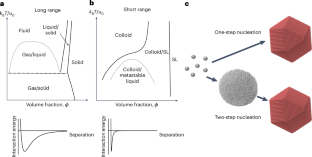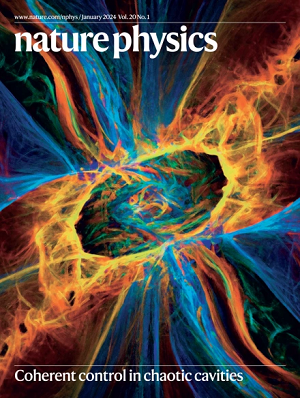Enhancing nanoscale charged colloid crystallization near a metastable liquid binodal
IF 18.4
1区 物理与天体物理
Q1 PHYSICS, MULTIDISCIPLINARY
引用次数: 0
Abstract
Achieving predictive control over crystallization using non-classical nucleation while avoiding kinetic traps would be a step towards designing materials with new functionalities. We address these challenges by inducing the bottom-up assembly of nanocrystals into ordered arrays, or superlattices. Using electrostatics—rather than density—to tune the interactions between particles, we watch self-assembly proceed through a metastable liquid phase. We systematically investigate the phase behaviour as a function of quench conditions in situ and in real time using small-angle X-ray scattering. By fitting to colloid, liquid and superlattice models, we extract the time evolution of each phase and the system phase diagram, which we find to be consistent with short-range attractive interactions. Using the predictive power of the phase diagram, we establish control of the self-assembly rate over three orders of magnitude, and we identify one- and two-step self-assembly regimes, with only the latter implicating the metastable liquid as an intermediate. The presence of the metastable liquid increases the superlattice formation rate relative to the equivalent one-step pathway, and the superlattice order increases with the rate, revealing a generalizable kinetic strategy for promoting and enhancing ordered assembly. Controlling nanoscale colloidal crystallization is not straightforward. Such control is now achieved by leveraging a metastable liquid phase of charged nanocrystals.


在亚稳液体双节点附近增强纳米级带电胶体结晶
利用非经典成核实现对结晶的预测控制,同时避免动力学陷阱,将是设计具有新功能的材料的一步。我们通过诱导纳米晶体自下而上组装成有序阵列或超晶格来解决这些挑战。利用静电——而不是密度——来调节粒子之间的相互作用,我们观察到自组装在亚稳液相中进行。我们系统地研究了相行为作为一个函数的淬火条件在原位和实时使用小角x射线散射。通过拟合胶体、液体和超晶格模型,我们提取了各相的时间演化和系统相图,我们发现它们与短程吸引相互作用是一致的。利用相图的预测能力,我们建立了超过三个数量级的自组装速率控制,并确定了一步和两步自组装制度,其中只有后者意味着亚稳液体作为中间体。相对于等效的一步路径,亚稳液体的存在增加了超晶格的形成速度,并且超晶格的有序度随着速度的增加而增加,揭示了促进和增强有序组装的可推广的动力学策略。
本文章由计算机程序翻译,如有差异,请以英文原文为准。
求助全文
约1分钟内获得全文
求助全文
来源期刊

Nature Physics
物理-物理:综合
CiteScore
30.40
自引率
2.00%
发文量
349
审稿时长
4-8 weeks
期刊介绍:
Nature Physics is dedicated to publishing top-tier original research in physics with a fair and rigorous review process. It provides high visibility and access to a broad readership, maintaining high standards in copy editing and production, ensuring rapid publication, and maintaining independence from academic societies and other vested interests.
The journal presents two main research paper formats: Letters and Articles. Alongside primary research, Nature Physics serves as a central source for valuable information within the physics community through Review Articles, News & Views, Research Highlights covering crucial developments across the physics literature, Commentaries, Book Reviews, and Correspondence.
 求助内容:
求助内容: 应助结果提醒方式:
应助结果提醒方式:


